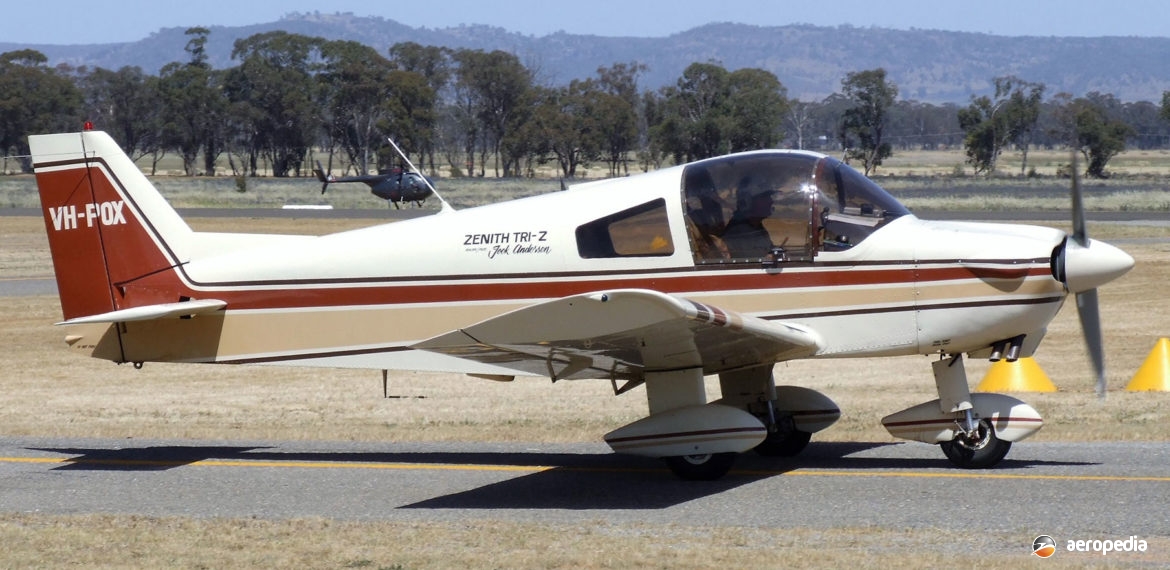Photograph:
Heintz CH-200 Zenith VH-POX (c/n 93) at Cowra, NSW in October 2007 (David C Eyre)
Country of origin:
France
Description:
Two-seat light sport aircraft
Power Plant:
One 75 kw (100 hp) Rolls Royce/Continental O-200 four-cylinder horizontally-opposed air-cooled engine
Specifications:
- Wingspan: 7 m (22 ft 11¾ in)
- Length: 6.3 m (20 ft 8 in)
- Height: 1,85 m (6 ft 0¾ in)
- Wing area: 9.8 m² (105.9 sq ft)
- Max speed at sea level: 233 km/h (145 mph)
- Cruising speed at 75% power: 215 km/h (134 mph)
- Max rate of climb at sea level: 240 m/min (787 ft/min)
- Service ceiling: 4,600 m (15,100 ft)
- Range: 800 km (497 miles)
- Empty weight: 400 kg (881 lb)
- Loaded weight: 680 kg (1,499 lb)
History:
Whilst working in France with Avions Pierre Robin, Mr Christopher Heintz, a professional aeronautical engineer, participated in the design of several light aircraft. He also designed and built a two-seat aircraft named the Zenith, which was intended for amateur construction. Work commenced in October 1968, and the prototype was flown for the first time on 22 March 1970. Subsequently, marketing of the plans and a construction manual was carried out by Zenair in Ontario, Canada, and more than 500 examples of the type have been built around the world, fitted with engines ranging from 63 kw (85 hp) to 134 kw (180 hp).
The Zenith CH-200 had accommodation for two, side-by-side, under a sideways-opening plexiglass canopy, dual controls being installed. Space for 35 kg (77 lb) of baggage was available behind the seats. The aircraft was of all-metal alloy structure, with aluminium alloy skin. A non-retractable tricycle undercarriage was fitted.
A number of variations of the design were made available, including the Acro-Zenith CH-150, the prototype of which first flew on 19 May 1980, which was developed from the Mono Z CH-100. The Acro-Zenith had a tailwheel undercarriage. The Super Acro-Zenith CH-180 was developed in 1982 and was an unlimited aerobatic model fitted with a 172 kw (230 hp) Avco Lycoming IO-360 engine. The Zenith CH-200, the first of which flew on 22 March 1970, was the most common, having been approved for construction in Australia, New Zealand, and 40 other countries.
The Zenith CH-250 was an improved version of the CH-200 with two 65 litre (14 Imp gal) fuel tanks in the wings and a 0.71 m³ (25 cub ft) baggage area, a forward sliding canopy, and modified windows. The Tri-Z CH-300, also known as the Tri-Zenith, was a three-seater with engines ranging from 86 kw (115 hp) to 119 kw (160 hp). It was a stretched version with a longer fuselage and an enlarged cabin to provide room for a rear bench seat able to carry a third adult or two children. The prototype with a 112 kw (150 hp) Avco Lycoming O-320 engine was first flown on 9 July 1977.
The Zenair Zodiac CH-600, which was first flown in June 1984, was designed for the less experienced pilot, having dual controls, a choice of tricycle or tailwheel undercarriage, and good handling characteristics. Normal power plant was a 1,875 cc modified Volkswagen. The Super Zodiac was similar to the CH-600, having a smaller wing with tapered outer wing panels and a turbocharged 2,300 cc Volkswagen conversion, which provided a cruising speed of 225 km/h (140 mph).
A number have been completed in Australia and New Zealand, these being CH-180, CH-200, CH-250, CH-600, etc, models. First of the type completed was VH-MAD (V40) in Victoria. In later times further examples have been completed, including a CH-200 VH-DYE (c/n V102) fitted with a Rotec R-3600 radial engine.

